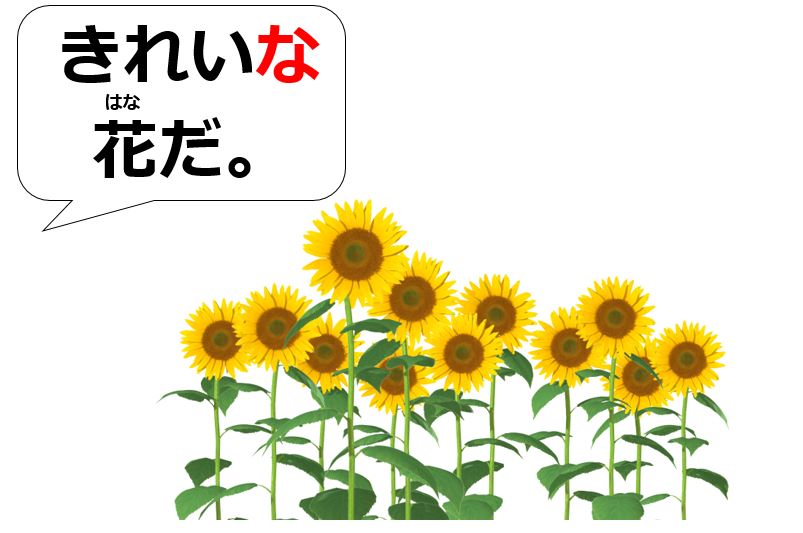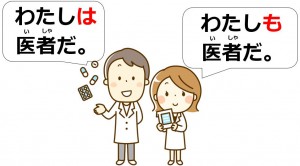Last time, you learned how to express state-of-being with a particular topic like “私は学生です (I’m a student).” Then, what should you do if you would like to say “I am a young student?” In this article, you will learn how to use Japanese adjectives with the particle が.
How to Modify a Noun Using Japanese Adjectives with the Particle が
| Table of Contents Na-adjective I-adjective Particle が |
Adjectives have two functions: the first is to directly modify a noun like “young student” and the second is being a complement like “students are young.” In Japanese, there are two types of adjectives called “na-adjective” and “i-adjective.” Let’s go over them with their functions one by one.
Na-adjectives
| 大変: difficult, hard |
| 立派: fine, splendid |
| 上手: well, skillful |
The above words are na-adjectives. When you directly modify a noun using a na-adjective, you need to put な between the noun and the adjective. This is the reason why it is called a na-adjective.
| 大変な仕事: hard job |
| 立派な家: splendid house |
| 上手な日本語: good Japanese |
When it comes to negative expressions, you can make the negative form with na-adjectives by attaching じゃない instead of な.
| 大変じゃない仕事: not hard job |
| 立派じゃない家: not splendid house |
| 上手じゃない日本語: not good Japanese |
Now, you can express state-of-being with na-adjectives. Both of the negative expressions are correct.
| 大変な仕事(だ / です)。 [It] is a hard job. |
| 立派じゃない家(だ / です)。 [It] is not a splendid house. |
| 上手な日本語(じゃない / じゃありません)。 [It] is not good Japanese. |
When you use a na-adjective as a subject complement, it will work in the same way as Japanese nouns. That is to say, you just need to add (だ / です)or (じゃない / じゃありません).
| 仕事が大変(だ / です)。 The job is hard. |
| 家が立派(じゃない / じゃありません)。 The house is not splendid. |
| 日本語が上手(だ / です)。 Lit. [Your] Japanese is good. |
Supplementary Learning
Japanese doesn’t have the equivalent word of “the.” You need to guess whether you’re talking about a specific thing or not based on contexts. Also, possessive markers like “your” is often omitted if contexts clearly tell who the possessor is.
[adsense]
I-adjectives
| かわいい: cute, lovely, charming, pretty |
| 新しい: new |
| 長い: long |
Adjectives which end with い are categorized into i-adjective. Unlike na-adjective, you don’t have to add anything when you directly modify a noun. Actually, a few na-adjectives also end with い, e.g. きれい and ゆうめい. You have to just memorize these kinds of exceptions. Jisho is a useful tool to look up part of speech.
| かわいい犬: cute dog |
| 新しい建物: new building |
| 長い話: long speech |
You can also make the negative form with i-adjectives by replacing the last い with く and adding ない.
| かわいくない犬: not cute dog |
| 新しくない建物: not new building |
| 長くない話: not long speech |
Now, you can express state-of-being with i-adjectives. Both of the negative expressions are correct.
| かわいい犬(だ / です)。 [He/She] is a cute dog. |
| 新しくない建物 (だ / です)。 [It] is not a new building. |
| 長い話(じゃない / じゃありません)。 [It] is not a long speech |
When you use i-adjectives as a subject complement, you MUST NOT do the same thing you do with na-adjectives. The variety of form is called “conjugation.” Using conjugation in place is significantly important when learning Japanese.
*There are two terms to express the modification of words which are “conjugation” and “inflection.” Linguistically speaking, there is difference between the two. However, for the sake of simplicity, we will only use “conjugation” for verbs, adjectives, and nouns in this grammar reference.
Conjugation of I-adjectives
| Casual | Polite (Colloquial) | Polite (Formal) | |
|---|---|---|---|
| Plain Form | かわいい | – | かわいいです |
| Negative Form | かわいくない | かわいくないです | かわいくありません |
When you express the plain form in a casual tone, you don’t attach anything. When you are using a polite tone, you attach です after i-adjectives. Regarding the negative form, you replace the last い with く and attach ない or ありません respectively. There is a colloquial expression. You can express the polite-negative form by attaching です to くない. You should be familiar with both of them.
| 犬がかわいい(です)。 [The] dog is cute. *かわいいだ is wrong! |
| 建物が新しく(ない / ないです/ ありません)。 [The] building is not new. |
| 話が長い(です)。 [The] speech is long. *長いだ is wrong! |
The Particle が
One question has probably come to your mind now; What is が in the examples above? The particle が has many functions, one of which is to express subjects of predicates. Here are more examples.
| 空が青い(です)。 [The] sky is blue. |
| ごはんが美味しい(です)。 [The] meals are delicious. |
| 図書館が静か(だ / です)。 Libraries are quiet. |
| 街が賑やか (だ / です)。 [The] towns are lively. |
If you would like to add a topic, it will be like this;
| 田舎は空が青い(です)。 As for the country, [the] sky is blue. |
| 東京は街が賑やか (だ / です)。 As for Tokyo, [the] towns are lively. |
Advanced Topic: The Second Function of the Particle が
There is a class in Japanese adjectives, which is called “adjectives of emotions.” The structure differs from the ones that you have been learning so far, which is “adjectives of states.” Let’s check the comparison.
Adjectives of States
| 田舎は | 空が | 青い(です) |
| Topic | Subject | Predicate |
| As for the country, [the] sky is blue. | ||
Adjectives of Emotions
| 私は | お父さんが | 心配(だ / です) |
| Topic / Subject | Object of Emotion | Predicate |
| I worry about my father. *”心配: worry” is a na-adjective in Japanese. |
||
When you express your emotions with adjectives, the topic and the subject are likely to be the same because if you are the topic, only you can feel your emotion. Thus, you need to use the topic particle は to set the topic and the subject. And, generally, objects of emotions are set by the particle が. This is the second function.
| [私は] | お母さんが | 好き(だ / です) |
| [Topic / Subject] | Object of Emotion | Predicate |
| [I] like my mother. *”好き: like” is a na-adjective in Japanese. |
||
If contexts clearly tell who you’re referring to, the は part can be omitted likewise.
When Adjectives of Emotion Don’t have Objects
With this case, objects of emotion accordingly disappear. And again, if contexts clearly tell who you’re referring to, the subject can be omitted. When you are talking about yourself, the subject is often clear enough to omit.
| [私は] | 嬉しい(です) | |
| [Topic / Subject] | Predicate | |
| [I] am glad. | ||
Note: The Subject CANNOT Be a Third Person
You cannot express other people’s emotions like this because you cannot exactly know other people’s mind. Thus, in this case, you need to use expressions of hearsay, guesses, questions, etc, which you will learn later in detail.
| Natural | 私はお父さんが心配 (だ / です)。 |
|---|---|
| Unnatural | 田中さんはお父さんが心配 (だ / です)。 |
Exception
| Natural | 田中さんはお父さんが好き(だ / です)。 Tanaka-san likes [his/her] father. |
|---|
好き is an exception. You can use this even if the subject is a third person
Summary
- When to directly modify a noun with na-adjectives, you place な like 大変な仕事.
- When na-adjectives work as a complement, it will work just like nouns, i.e. 仕事が大変(だ / です)or (じゃない / じゃありません).
- When to directly modify a noun with i-adjectives, you just connect them like かわいい子供.
- When i-adjectives work as a complement, you conjugate them like 子供がかわいい(です)or かわいく(ない / ありません).
- The particle が expresses subjects of predicates.
- (Advanced) The particle が expresses objects of emotions.
Now, you know how to use Japanese adjectives with the particle が. You might wonder when a topic and a subject are same like “cats are cute,” which particle you should use, は or が. Actually, both 猫はかわいい and 猫がかわいい are correct and natural Japanese, but the nuances are different. You will learn the usage in detail with Japanese verbs next.





